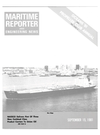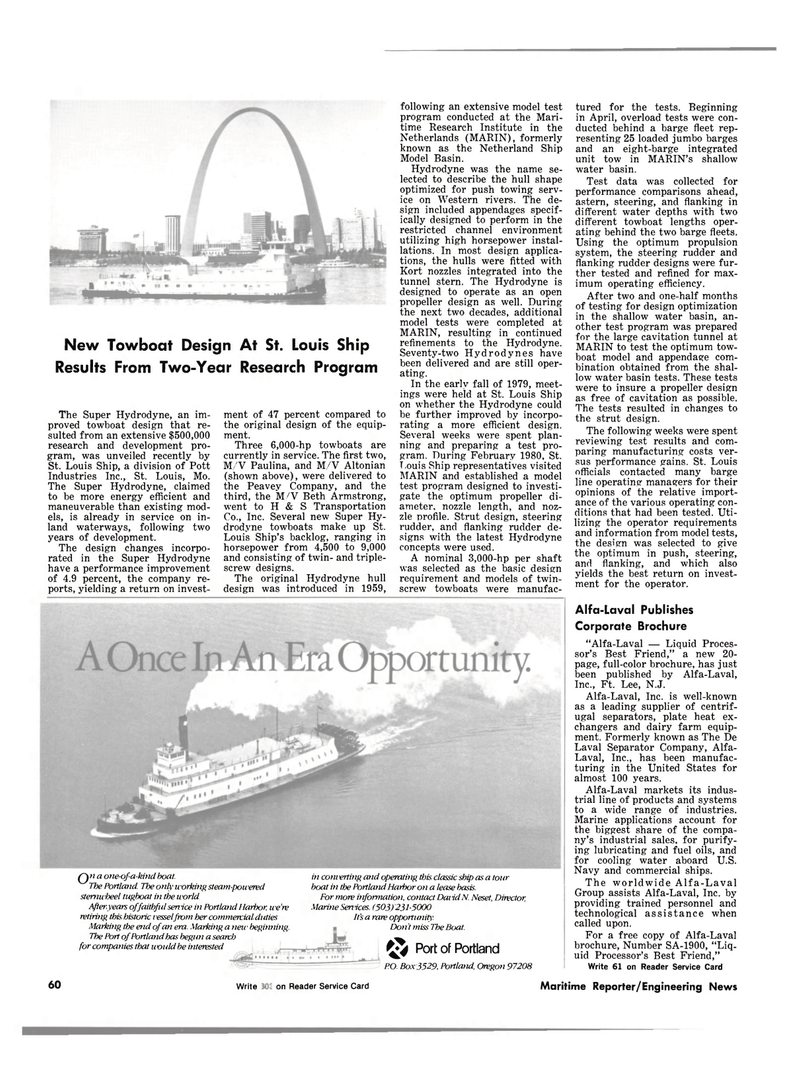
Page 58: of Maritime Reporter Magazine (September 15, 1981)
Read this page in Pdf, Flash or Html5 edition of September 15, 1981 Maritime Reporter Magazine
New Towboat Design At St. Louis Ship
Results From Two-Year Research Program
The Super Hydrodyne, an im- proved towboat design that re- sulted from an extensive $500,000 research and development pro- gram, was unveiled recently by
St. Louis Ship, a division of Pott
Industries Inc., St. Louis, Mo.
The Super Hydrodyne, claimed to be more energy efficient and maneuverable than existing mod- els, is already in service on in- land waterways, following two years of development.
The design changes incorpo- rated in the Super Hydrodyne have a performance improvement of 4.9 percent, the company re- ports, yielding a return on invest- ment of 47 percent compared to the original design of the equip- ment.
Three 6,000-hp towboats are currently in service. The first two,
M/V Paulina, and M/V Altonian (shown above), were delivered to the Peavey Company, and the third, the M/V Beth Armstrong, went to H & S Transportation
Co., Inc. Several new Super Hy- drodyne towboats make up St.
Louis Ship's backlog, ranging in horsepower from 4,500 to 9,000 and consisting of twin- and triple- screw designs.
The original Hydrodyne hull design was introduced in 1959, following an extensive model test program conducted at the Mari- time Research Institute in the
Netherlands (MARIN), formerly known as the Netherland Ship
Model Basin.
Hydrodyne was the name se- lected to describe the hull shape optimized for push towing serv- ice on Western rivers. The de- sign included appendages specif- ically designed to perform in the restricted channel environment utilizing high horsepower instal- lations. In most design applica- tions, the hulls were fitted with
Kort nozzles integrated into the tunnel stern. The Hydrodyne is designed to operate as an open propeller design as well. During the next two decades, additional model tests were completed at
MARIN, resulting in continued refinements to the Hydrodyne.
Seventy-two Hydrodynes have been delivered and are still oper- ating.
In the early fall of 1979, meet- ings were held at St. Louis Ship on whether the Hydrodyne could be further improved by incorpo- rating a more efficient design.
Several weeks were spent plan- ning and preparing a test pro- gram. During February 1980, St.
Louis Ship representatives visited
MARIN and established a model test program designed to investi- gate the optimum propeller di- ameter. nozzle length, and noz- zle profile. Strut design, steering rudder, and flanking rudder de- signs with the latest Hydrodyne concepts were used.
A nominal 3,000-hp per shaft was selected as the basic design requirement and models of twin- screw towboats were manufac-
Qn a one-of-a-kind boat.
The Portland. Tlx only u'orking steam-powered stemwlxel tugboat in the u'orld
After years of faithful sen'ice in Portland Harbor, we're retiring this historic i 'esse/ from her commercial duties
Marking the end of an era. Marking a new beginning.
The Port of Portland has begun a search for companies that would be interested in comerting and operating this classic ship as a tour boat in tlx Portland Harbor on a lease basis.
For more infonnation, contact David N. Neset, Director,
Marine Sen ices. (503) 231-5000
It's a rare opportunity.
Don't miss The Boat. $ Port of Portland
P.O. Box3529, Portland, Oregon 97208 tured for the tests. Beginning in April, overload tests were con- ducted behind a barge fleet rep- resenting 25 loaded jumbo barges and an eight-barge integrated unit tow in MARIN's shallow water basin.
Test data was collected for performance comparisons ahead, astern, steering, and flanking in different water depths with two different towboat lengths oper- ating behind the two barge fleets.
Using the optimum propulsion system, the steering rudder and flanking rudder designs were fur- ther tested and refined for max- imum operating efficiency.
After two and one-half months of testing for design optimization in the shallow water basin, an- other test program was prepared for the large cavitation tunnel at
MARIN to test the optimum tow- boat model and appendage com- bination obtained from the shal- low water basin tests. These tests were to insure a propeller design as free of cavitation as possible.
The tests resulted in changes to the strut design.
The following weeks were spent reviewing test results and com- paring manufacturing costs ver- sus performance gains. St. Louis officials contacted many barge line operating managers for their opinions of the relative import- ance of the various operating con- ditions that had been tested. Uti- lizing the operator requirements and information from model tests, the design was selected to give the optimum in push, steering, and flanking, and which also yields the best return on invest- ment for the operator.
Alfa-Laval Publishes
Corporate Brochure "Alfa-Laval — Liquid Proces- sor's Best Friend," a new 20- page, full-color brochure, has just been published by Alfa-Laval,
Inc., Ft. Lee, N.J.
Alfa-Laval, Inc. is well-known as a leading supplier of centrif- ugal separators, plate heat ex- changers and dairy farm equip- ment. Formerly known as The De
Laval Separator Company, Alfa-
Laval, Inc., has been manufac- turing in the United States for almost 100 years.
Alfa-Laval markets its indus- trial line of products and systems to a wide range of industries.
Marine applications account for the biggest share of the compa- ny's industrial sales, for purify- ing lubricating and fuel oils, and for cooling water aboard U.S.
Navy and commercial ships.
The worldwide Alfa-Laval
Group assists Alfa-Laval, Inc. by providing trained personnel and technological assistance when called upon.
For a free copy of Alfa-Laval brochure, Number SA-1900, "Liq- uid Processor's Best Friend,"
Write 61 on Reader Service Card 60 Write 259 on Reader Service Card Maritime Reporter/Engineering News

 57
57

 59
59
